[This article now cross-published by Salon...]
 Despite a larger population and a contested race for an open gubernatorial seat, turnout in the state of Texas was reportedly down this year, as compared to the last mid-term election in 2010, by more than a quarter of a million votes.
Despite a larger population and a contested race for an open gubernatorial seat, turnout in the state of Texas was reportedly down this year, as compared to the last mid-term election in 2010, by more than a quarter of a million votes.
That data point --- a decrease of some 271,000 total voters this year --- is one of several, at least anecdotal early indicators that suggest the Texas GOP's strategy of suppressing the vote this year with polling place Photo ID restrictions seems to have worked.
Since 2003, Texas law had already required every voter to present an ID when voting at the polls in the Lone Star State. But the newer draconian restrictions that have been so controversial were finally in place for a federal general election for the first time this year, after state Republicans have been attempting to enact them since at least 2007.
We've spent quite a bit of time over the past year(s) reporting on the GOP attempt to implement these new polling place Photo ID voting restrictions, with all evidence suggesting that they are meant only to suppress the votes of minorities, students, the poor and other disproportionately Democratic-leaning constituencies.
In virtually every instance that the new, exceedingly restrictive law has come before federal authorities, it has been found plainly discriminatory. The law was struck down in 2012 as a discriminatory violation of the Voting Rights Act by both the U.S. Department of Justice as well as a three-judge federal panel on the D.C. District Court. It was struck down once again this year by a U.S. District Court in Texas after a full trial and a 147-page ruling [PDF] which found the law to be "purposefully discriminatory", an "unconstitutional poll tax", and likely to disenfranchise some 600,000 legally registered Texas voters as well as more than a million eligible voters.
Nonetheless, the U.S. Supreme Court allowed it to stay in place during this year's election, as the Republicans who run the state of Texas appeal the lower court's unambiguous ruling.
In the meantime, early data coming in from Texas suggests the law appears to have had its intended effect...
It was reported on the day after the election last week that the number of provisional ballots cast in TX had doubled, as compared to the last mid-term elections in 2010.
Since voters lacking one of the few, very specific types of state-issued Photo IDs required to vote under the new law would only have been able to cast a provisional ballot at the polls on Election Day (which will not be counted unless the voter can return to county election headquarters with approved Photo ID within 6 days after the election), it makes sense that provisional ballots would increase under the new voting restriction.
It could be argued that increased turnout this year over 2010 would also lead to an increase in provisional ballots. However, the turnout in Texas was down this year, not up.
In another indication that the law is "working" for Republicans, despite the vigorously contested gubernatorial race between Republican Attorney General Greg Abbott (who also led the legal battle for the new voting restrictions) and Democratic state Sen. Wendy Davis this year, voter turnout was way down in Texas as compared to the 2010 election. According to the Texas Tribune's Ross Ramsey in the New York Times over the weekend, turnout fell by 271,000 voters this year, compared to 2010, despite several factors that might otherwise have suggested it should have gone up this year...
The people who did not show up appear to be Democrats. The Republican numbers were up in the governor’s race, while the Democratic numbers were way down.
It will take some time to determine exactly what did and didn't happen in this year's elections, and certainly how the new voting restriction effected voters, but early indications are similar to the findings reported by the non-partisan U.S. Government Accountability Office (GAO) after similar voting restrictions were implemented by Republicans in Kansas and Tennessee. In those states, the GAO found, the voting restrictions had the effect of lowering turnout most markedly for both minority and young voters.
How much turnout was lowered in TX due to the new restrictions remain to be seen. As the Texas Tribune's Ramsey also notes in the Times, since Abbott appears to have reportedly defeated Davis by nearly 1 million votes, it seems unlikely that Democrats would have won that particular election even without the new, unconstitutional law in place.
Still, as we've reported here many, many times over the years, our concern is not about who wins and loses any particular election. It's about the ability of Americans to exercise their right to vote, should they choose to, and to have that vote counted, counted accurately and in a way that they can know it's been counted accurately.
There is no question that the new Republican law kept voters from being able to exercise their rights in Texas. We've already reported how 93-year old veterans and born and raised Texans were kept from voting, as well as student voters unable to vote now that state-issued student Photo IDs are disallowed for the first time. Others have similarly reported a "surge of disenfranchised voters" this year in Texas.
Whether or not it directly affected election outcomes specifically (and, if the early numbers are correct, it would almost certainly have had an effect on smaller, closer contests throughout the state), the right to vote is --- or, at least should be --- sacred. Republicans enjoy pretending that's the case when they argue in favor of strict Photo ID restrictions and others that serve only to suppress the right to vote. Democrats, and those of us who really do give a damn about the right to vote, ought to be fighting like hell for that right, no matter how many specific election outcomes may or may not be at stake.
(Snail mail support to "Brad Friedman, 7095 Hollywood Blvd., #594 Los Angeles, CA 90028" always welcome too!)
|


 Appeals Court Blocks Last Route for Voters to Challenge Violations of the VRA: 'BradCast' 5/19/25
Appeals Court Blocks Last Route for Voters to Challenge Violations of the VRA: 'BradCast' 5/19/25 Sunday 'Now Hoarding' Toons
Sunday 'Now Hoarding' Toons Mad World:
Mad World: 'Green News Report' 5/15/25
'Green News Report' 5/15/25
 Plane Corruption and the Future of the DOJ: 'BradCast' 5/14/25
Plane Corruption and the Future of the DOJ: 'BradCast' 5/14/25 'Deeply Evil': GOP Proposes Largest Medicaid Cuts in History: 'BradCast' 5/13/25
'Deeply Evil': GOP Proposes Largest Medicaid Cuts in History: 'BradCast' 5/13/25 'Green News Report' 5/13/25
'Green News Report' 5/13/25 And Then They Came for the Mayors...: 'BradCast' 5/12/25
And Then They Came for the Mayors...: 'BradCast' 5/12/25 Sunday 'New Guy, Old Guy' Toons
Sunday 'New Guy, Old Guy' Toons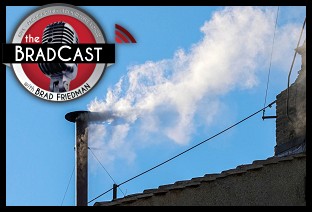 Blowing Smoke. At the Vatican and White House: 'BradCast' 5/8/25
Blowing Smoke. At the Vatican and White House: 'BradCast' 5/8/25 'Green News Report' 5/8/25
'Green News Report' 5/8/25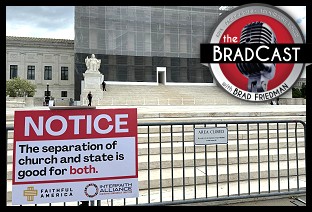 SCOTUS Weighs Public Funding of Religious Schools: 'BradCast' 5/7/25
SCOTUS Weighs Public Funding of Religious Schools: 'BradCast' 5/7/25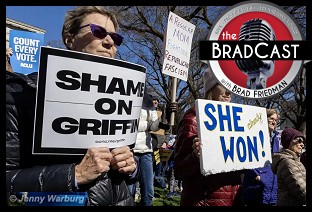 Trump Judge Blocks NC GOP Theft of 2024 Supreme Court Seat: 'BradCast' 5/6/25
Trump Judge Blocks NC GOP Theft of 2024 Supreme Court Seat: 'BradCast' 5/6/25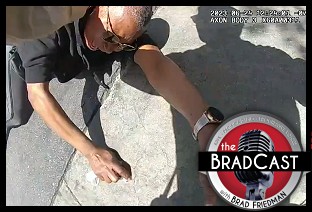 Prosecutors Quit After U.S Attny Strikes Deal With Felon Cop: 'BradCast' 5/5/25
Prosecutors Quit After U.S Attny Strikes Deal With Felon Cop: 'BradCast' 5/5/25 Trump Losing Streak Continues into SECOND Hundred Days: 'BradCast' 5/1/25
Trump Losing Streak Continues into SECOND Hundred Days: 'BradCast' 5/1/25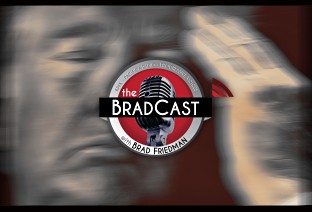 100 Daze (w/ Digby and Driftglass): 'BradCast' 4/30/25
100 Daze (w/ Digby and Driftglass): 'BradCast' 4/30/25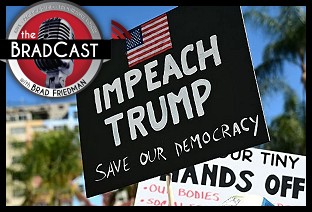 Campaign to 'Impeach Trump Again' Gains Fresh Momentum: 'BradCast' 4/29/25
Campaign to 'Impeach Trump Again' Gains Fresh Momentum: 'BradCast' 4/29/25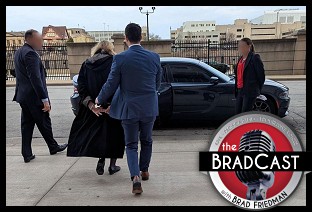 And Then They Came for the Judges...: 'BradCast' 4/28/25
And Then They Came for the Judges...: 'BradCast' 4/28/25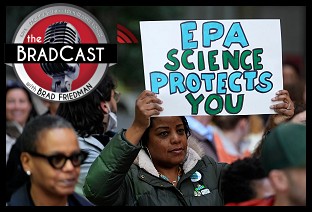 Trump EPA Guts Enviro Justice Office: 'BradCast' 4/24/25
Trump EPA Guts Enviro Justice Office: 'BradCast' 4/24/25
 VA GOP VOTER REG FRAUDSTER OFF HOOK
VA GOP VOTER REG FRAUDSTER OFF HOOK Criminal GOP Voter Registration Fraud Probe Expanding in VA
Criminal GOP Voter Registration Fraud Probe Expanding in VA DOJ PROBE SOUGHT AFTER VA ARREST
DOJ PROBE SOUGHT AFTER VA ARREST Arrest in VA: GOP Voter Reg Scandal Widens
Arrest in VA: GOP Voter Reg Scandal Widens ALL TOGETHER: ROVE, SPROUL, KOCHS, RNC
ALL TOGETHER: ROVE, SPROUL, KOCHS, RNC LATimes: RNC's 'Fired' Sproul Working for Repubs in 'as Many as 30 States'
LATimes: RNC's 'Fired' Sproul Working for Repubs in 'as Many as 30 States' 'Fired' Sproul Group 'Cloned', Still Working for Republicans in At Least 10 States
'Fired' Sproul Group 'Cloned', Still Working for Republicans in At Least 10 States FINALLY: FOX ON GOP REG FRAUD SCANDAL
FINALLY: FOX ON GOP REG FRAUD SCANDAL COLORADO FOLLOWS FLORIDA WITH GOP CRIMINAL INVESTIGATION
COLORADO FOLLOWS FLORIDA WITH GOP CRIMINAL INVESTIGATION CRIMINAL PROBE LAUNCHED INTO GOP VOTER REGISTRATION FRAUD SCANDAL IN FL
CRIMINAL PROBE LAUNCHED INTO GOP VOTER REGISTRATION FRAUD SCANDAL IN FL Brad Breaks PA Photo ID & GOP Registration Fraud Scandal News on Hartmann TV
Brad Breaks PA Photo ID & GOP Registration Fraud Scandal News on Hartmann TV  CAUGHT ON TAPE: COORDINATED NATIONWIDE GOP VOTER REG SCAM
CAUGHT ON TAPE: COORDINATED NATIONWIDE GOP VOTER REG SCAM CRIMINAL ELECTION FRAUD COMPLAINT FILED AGAINST GOP 'FRAUD' FIRM
CRIMINAL ELECTION FRAUD COMPLAINT FILED AGAINST GOP 'FRAUD' FIRM RICK SCOTT GETS ROLLED IN GOP REGISTRATION FRAUD SCANDAL
RICK SCOTT GETS ROLLED IN GOP REGISTRATION FRAUD SCANDAL VIDEO: Brad Breaks GOP Reg Fraud Scandal on Hartmann TV
VIDEO: Brad Breaks GOP Reg Fraud Scandal on Hartmann TV RNC FIRES NATIONAL VOTER REGISTRATION FIRM FOR FRAUD
RNC FIRES NATIONAL VOTER REGISTRATION FIRM FOR FRAUD EXCLUSIVE: Intvw w/ FL Official Who First Discovered GOP Reg Fraud
EXCLUSIVE: Intvw w/ FL Official Who First Discovered GOP Reg Fraud GOP REGISTRATION FRAUD FOUND IN FL
GOP REGISTRATION FRAUD FOUND IN FL

































